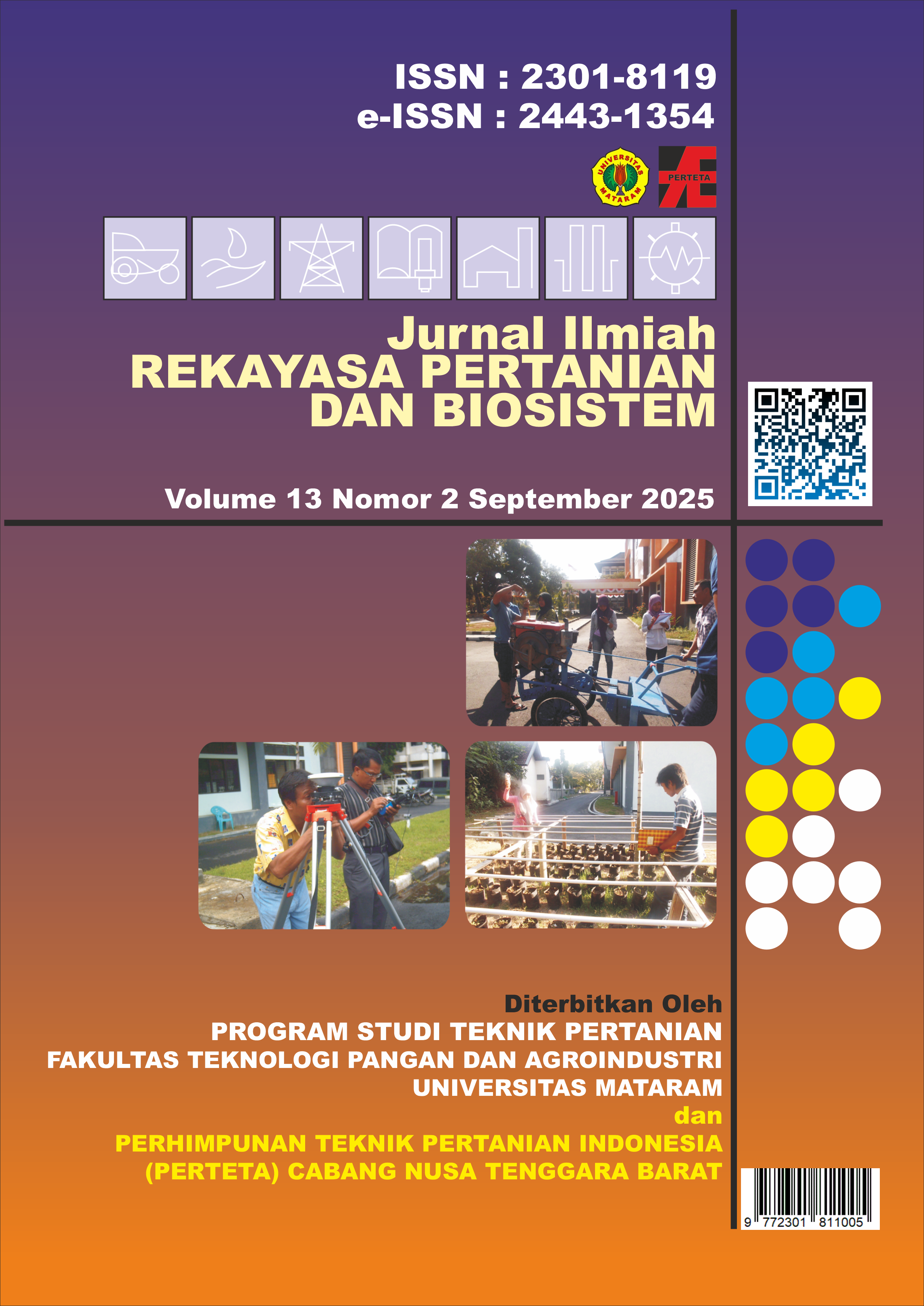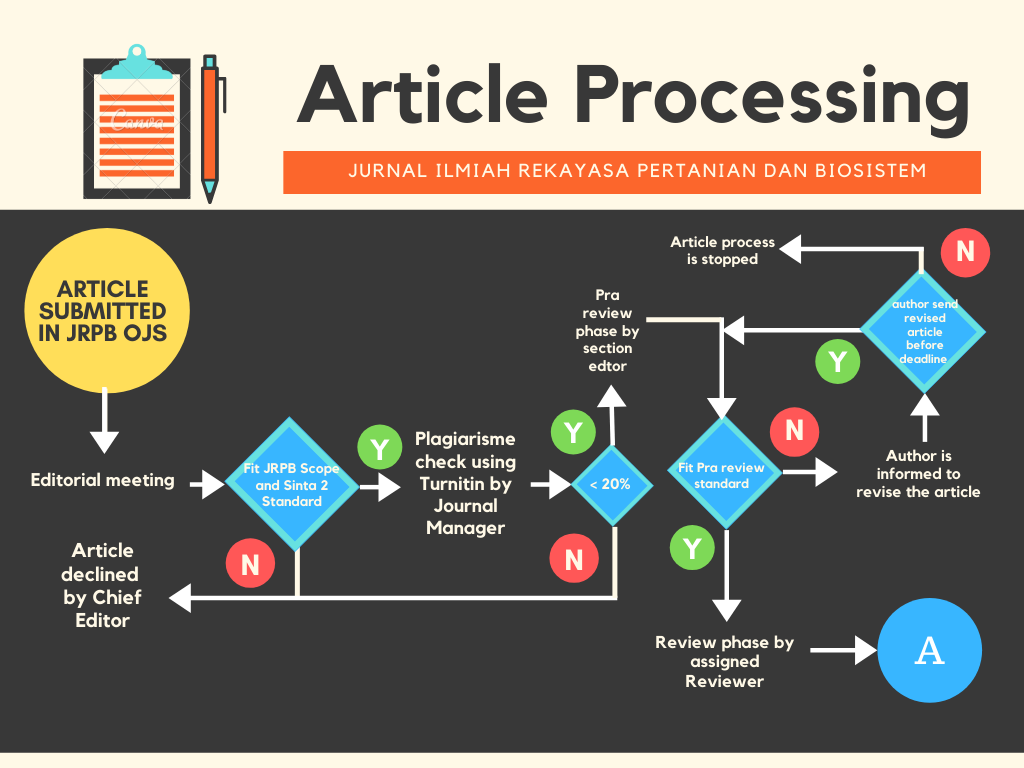Modeling Microwave Oven Sterilization of Palm Fruit using Response Surface Methodology (RSM)
Authors
Dewi Fortuna , Diana Pebriani Daulay , Lavlinesia , Arzita , Eli SoviaDOI:
10.29303/jrpb.v13i2.1190Published:
2025-09-29Issue:
Vol. 13 No. 2 (2025): Jurnal Ilmiah Rekayasa Pertanian dan BiosistemKeywords:
CCD, CPO, Dry heat sterilization, Electromagnetic magnetic, FFAArticles
Downloads
How to Cite
Downloads
Abstract
The conventional steam-based sterilization of crude palm oil (CPO) in Indonesia is known to be energy- and water-intensive, as well as time-consuming. This necessitates more efficient and sustainable alternatives, such as microwave oven heating. While microwave applications in CPO sterilization have been explored as a more efficient and sustainable alternative, existing studies often lack comprehensive optimization and a systematic investigation of key process parameters. This study aimed to optimize fresh fruit bunch (FFB) sterilization using a microwave oven to identify optimal operating parameters for maximizing oil extraction yield and minimizing Free Fatty Acid (FFA) content. The Central Composite Design (CCD) within Response Surface Methodology (RSM) was employed as a statistical technique to model the process and ensure the validity of the results. Three independent variables were investigated: sterilization time (6–20 min), fruit mass (396–1104 g), and fruit maturity level (ripe and over-ripe), resulting in twenty-six experimental combinations. Optimal conditions for maximum yield and lowest FFA were determined at 6 min sterilization time and 550 g fruit mass for both maturity levels. Conversely, suboptimal conditions at 11.5 min and 150 g fruit mass for both maturity levels resulted in the lowest yield and highest FFA. This research provides crucial insights for developing an optimized microwave sterilization technique, enhancing palm oil processing efficiency and product quality. The findings underscore the potential for a scalable, low-energy sterilization method that could significantly reduce the environmental footprint of CPO production, instilling optimism about the positive impact of this research.
References
Ali, F. S., Shamsudin, R., & Yunus, R. (2014). The Effect of Storage Time of Chopped Oil Palm Fruit Bunches on the Palm Oil Quality. Agriculture and Agricultural Science Procedia, 2(December), 165–172. https://doi.org/10.1016/j.aaspro.2014.11.024 DOI: https://doi.org/10.1016/j.aaspro.2014.11.024
American Oil Chemists’ Society. (2009). AOCS Official Method Ca 5a-40: Free Fatty Acids. AOCS. Association of Official Analytical Chemists.
Chang, J. S. L., Law, M. C., Chan, Y. S., & Leo, C. P. (2015). Effects of Microwave Heating on Oil Palm Mesocarp. Chemical Engineering Transactions, 45(October 2015), 1633–1638. https://doi.org/10.3303/CET1545273
Cheng, S. F., Nor L., M., & Chuah, C. H. (2011). Microwave Pretreatment: A Clean and Dry Method for Palm Oil Production. Industrial Crops and Products, 34(1), 967–971. https://doi.org/10.1016/j.indcrop.2011.03.002 DOI: https://doi.org/10.1016/j.indcrop.2011.03.002
Chow, M. C., & Ma, A. N. (2007). Processing of Fresh Palm Fruits using Microwaves. Journal of Microwave Power and Electromagnetic Energy, 40(3), 165–173. https://doi.org/10.1080/08327823.2005.11688538 DOI: https://doi.org/10.1080/08327823.2005.11688538
Gabungan Pengusaha Kelapa Sawit Indonesia. (2022). Kinerja Industri Sawit 2021 dan Prospek 2022. https://gapki.id/news/2022/01/29/kinerja-industri-sawit-2021-prospek-2022/
Junaidah, M. J., Norizzah, A. R., Zaliha, O., & Mohamad, S. (2015). Optimisation of Sterilisation Process for Oil Palm Fresh Fruit Bunch at Different Ripeness. International Food Research Journal, 22(1), 275–282.
Jusoh, J. M., Rashid, N. A., & Omar, Z. (2013). Effect of Sterilization Process on Deterioration of Bleachability Index (DOBI) of Crude Palm Oil (CPO) Extracted from Different Degree of Oil Palm Ripeness. International Journal of Bioscience, Biochemistry and Bioinformatics, 3(4), 322–327. https://doi.org/10.7763/IJBBB.2013.V3.223
Kumaradevan, D., Chuah, K. H., Moey, L. K., Mohan, V., & Wan, W. T. (2015). Optimising the Operational Parameters of a Spherical Steriliser for the Treatment of Oil Palm Fresh Fruit Bunch. IOP Conference Series: Materials Science and Engineering, 88(1), 1–6. https://doi.org/10.1088/1757-899X/88/1/012031 DOI: https://doi.org/10.1088/1757-899X/88/1/012031
Kusuma, H. S., Sudrajat, R. G. M., Susanto, D. F., Gala, S., & Mahfud, M. (2015). Response Surface Methodology (RSM) Modeling of Microwave-Assisted Extraction of Natural Dye from Swietenia mahagony: A Comparation between Box-Behnken and Central Composite Design Method. International Conference of Chemical and Material Engineering, 1699, 050009. https://doi.org/10.1063/1.4938345 DOI: https://doi.org/10.1063/1.4938345
Law, M. C., Chang, J. S. L., Chan, Y. S., Pui, D. Y., You, K. Y., Chang, J. S. L., Chan, Y. S., Pui, D. Y., & You, K. Y. (2018). Experimental Characterization and Modeling of Microwave Heating of Oil Palm Kernels , Mesocarps and Empty Fruit Bunches. Drying Technology, 1(1), 1–23. https://doi.org/10.1080/07373937.2018.1439057 DOI: https://doi.org/10.1080/07373937.2018.1439057
Liew, W. L., Kassim, M. A., Muda, K., Loh, S. K., & Affam, A. C. (2015). Conventional Methods and Emerging Wastewater Polishing Technologies for Palm Oil Mill Effluent Treatment: A Review. Journal of Environmental Management, 149, 222–235. https://doi.org/10.1016/j.jenvman.2014.10.016 DOI: https://doi.org/10.1016/j.jenvman.2014.10.016
Ma’rufah, U., June, T., Faqih, A., Koesmaryono, Y., Ali, A. A., & Knohl, A. (2023). Projection of Further Expansion of Oil Palm Plantation in Jambi Province. Journal of Natural Resources and Environmental Management, 13(3), 484–493. https://doi.org/10.29244/jpsl.13.3.484-493 DOI: https://doi.org/10.29244/jpsl.13.3.484-493
Mohammad, S., Baidurah, S., Kobayashi, T., Ismail, N., & Leh, C. P. (2021). Palm Oil Mill Effluent Treatment Processes—A Review. Processes, 9(5), 1–22. https://doi.org/10.3390/pr9050739 DOI: https://doi.org/10.3390/pr9050739
Montgomery, D. C. (2017). Design and Analysis of Experiments, John Wiley & Sons. In Wiley (Ninth Edit). Joh Wiley & Sons, Inc.
Nokkaew, R. (2014). Sterilization of Oil Palm Fruits by Microwave Heating for Replacing Steam Treatment in Palm Oil Mill Process. Advanced Materials Research, 1025–1026(1), 470–475. https://doi.org/10.4028/www.scientific.net/AMR.1025-1026.470 DOI: https://doi.org/10.4028/www.scientific.net/AMR.1025-1026.470
Pakdeechot, S., Hanifarianty, S., & Wae-hayee, M. (2021). Effects of Sterilization Times of Palm Bunches on Fruit-Bunch Separation, Crude Palm Oil Yield and Quality Using Direct Steaming. Journal of Advanced Research in Fluid Mechanics and Thermal Sciences, 82(1), 1–9. https://doi.org/10.37934/arfmts.82.2.3946 DOI: https://doi.org/10.37934/aram.72.1.19
Sarah, M., Madinah, I., & Salamah, S. (2018). Response Surface Methodology to Optimize Microwave Sterilization of Palm Fruit. Journal of Physics: Conference Series, 1028(1), 1–7. https://doi.org/10.1088/1742-6596/1028/1/012004 DOI: https://doi.org/10.1088/1742-6596/1028/1/012004
Sarah, M., & Taib, M. R. (2013). Enzymatic Destruction Kinetics of Oil Palm Fruits by Microwave Sterilization. International Journal of Chemical Engineering and Applications, 4(3), 129–133. https://doi.org/10.7763/ijcea.2013.v4.278 DOI: https://doi.org/10.7763/IJCEA.2013.V4.278
Sovia, E., Rahmi, S. L., & Fortuna, D. (2024). Pengaruh Penggunaan Microwave Oven terhadap Proses Sterilisasi Buah Kelapa Sawit. Jurnal Ilmiah Rekayasa Pertanian Dan Biosistem, 12(1), 110–125. https://doi.org/10.29303/jrpb.v12i1.585 DOI: https://doi.org/10.29303/jrpb.v12i1.585
Thang, Y. M., Yunus, R., Mokhtar, M. N., Appleton, D. R., Asis, A. J., Kong, P. S., Teh, H. F., & Ariffin, A. A. (2021). Roles and Principles of Sterilisation Process in Palm Oil Mills. Pertanika Journal of Science and Technology, 29(4), 2705–2722. https://doi.org/10.47836/PJST.29.4.26 DOI: https://doi.org/10.47836/pjst.29.4.26
License
Copyright (c) 2025 Diana Pebriani Daulay, Dewi Fortuna, Lavlinesia, Arzita, Eli Sovia

This work is licensed under a Creative Commons Attribution-ShareAlike 4.0 International License.
Authors who publish with this journal agree to the following terms:
- Authors retain copyright and grant the journal right of first publication with the work simultaneously licensed under a Creative Commons Attribution License 4.0 International License (CC-BY-SA License). This license allows authors to use all articles, data sets, graphics, and appendices in data mining applications, search engines, web sites, blogs, and other platforms by providing an appropriate reference. The journal allows the author(s) to hold the copyright without restrictions and will retain publishing rights without restrictions.
- Authors are able to enter into separate, additional contractual arrangements for the non-exclusive distribution of the journal's published version of the work (e.g., post it to an institutional repository or publish it in a book), with an acknowledgement of its initial publication in Jurnal Ilmiah Rekayasa Pertanian dan Biosistem (JRPB).
- Authors are permitted and encouraged to post their work online (e.g., in institutional repositories or on their website) prior to and during the submission process, as it can lead to productive exchanges, as well as earlier and greater citation of published work (See The Effect of Open Access).










